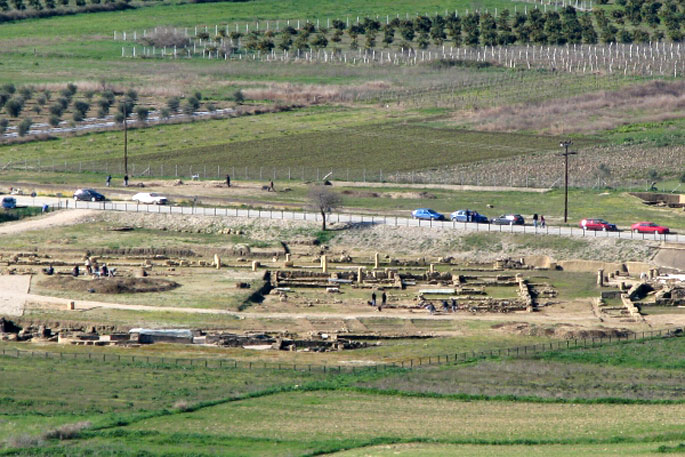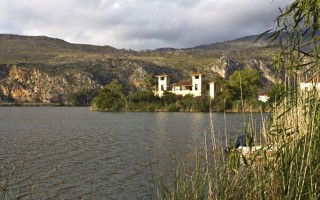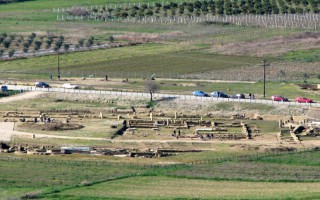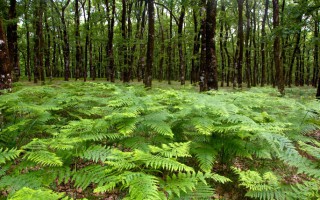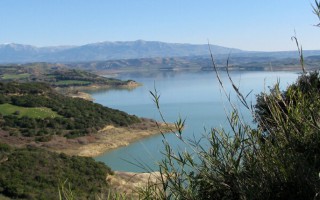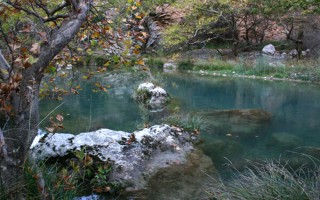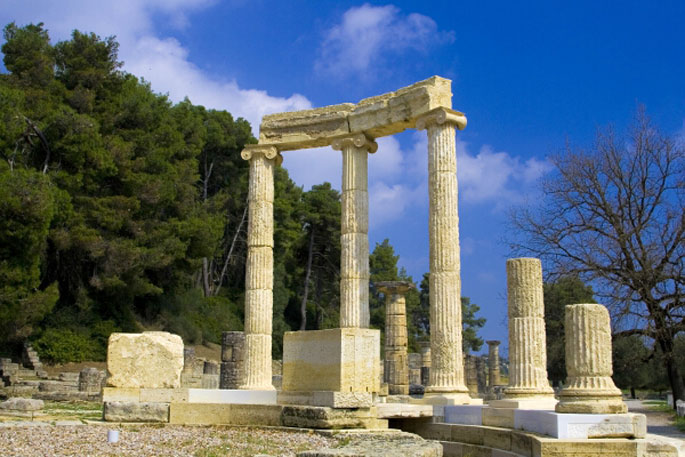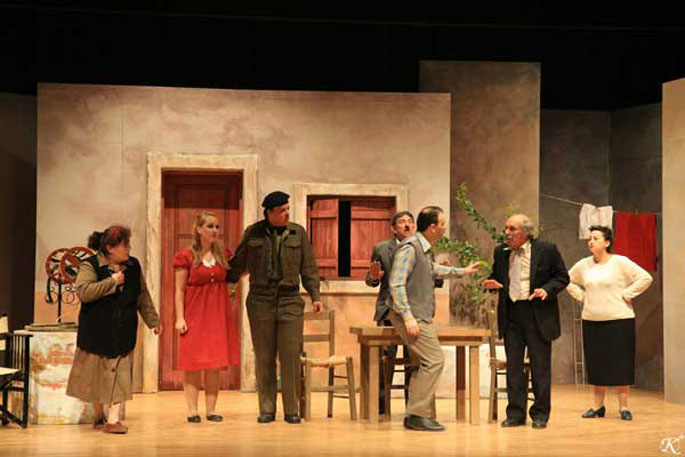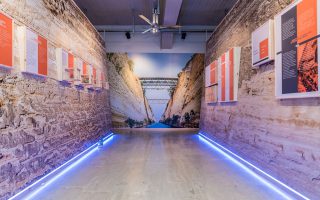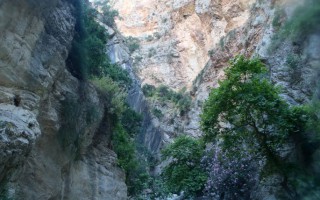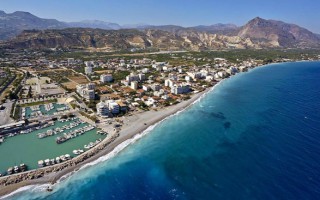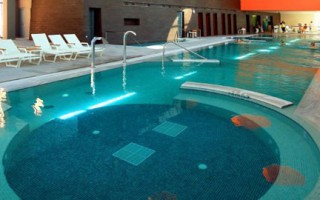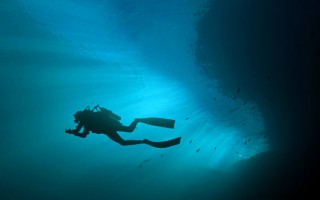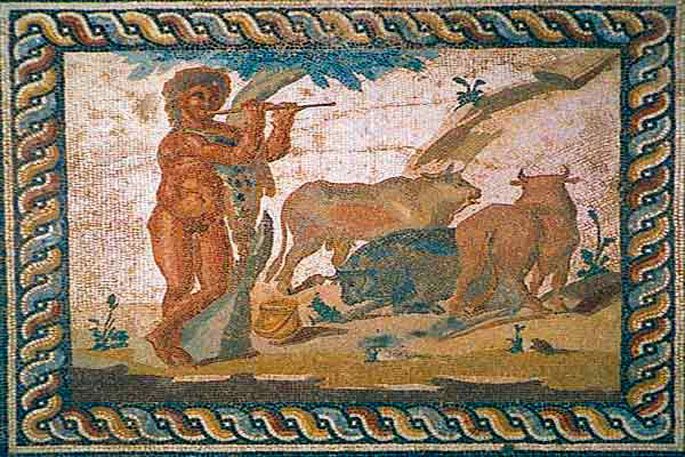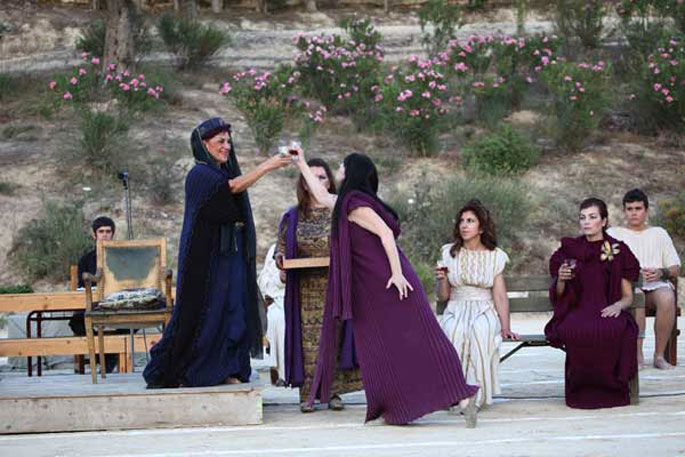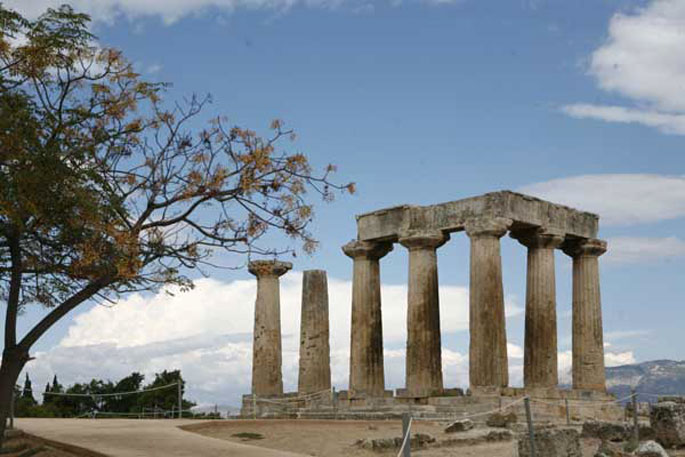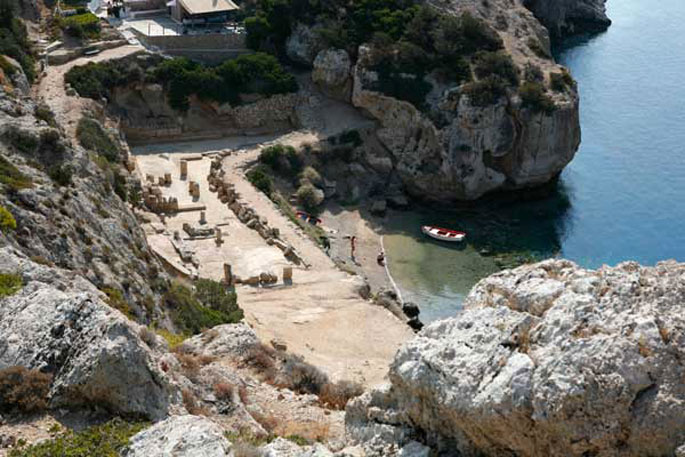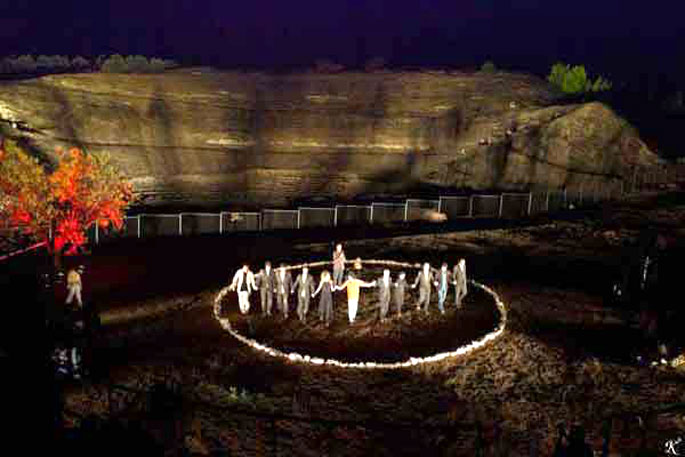Ilida or Ilis was a city-state in ancient Ilia, very near ancient Olympia, and took up the area which today extends from the village of Paliopoli (or Nea Ilida) to the southeast, Bouchioti (or Avgeio) to the southwest and Kalyvia to the west. According to myth, it was founded by Oxylus, son of Aemon and Gorgi, who is also mentioned in some traditions as the founder of the Olympic Games. Oxylus, who hailed from Aetolia, founded Ilida by merging all pre-existing towns in the area, and became its first king.
Ilida placed a lot of emphasis on the organization of the Olympic Games, which took place every four years. Before and during the games the whole area came alive; a month before the games began, all athletes were to come to Ilida to train. Many came with their friends and family, from various parts of the country.
The city of Ilida had many temples and sanctuaries, such as the temple of the Charites, the temple of Seilinos, the temple of Hades, the sanctuary of Tyche, the sanctuary of Dionysus, the shrine of Achilles and many others. The city saw great prosperity, until about the 4th century, when the first signs of decline slowly appeared. The final end came some centuries later, with the destructive earthquake of the 6th century A.D.
Ilida was one of the most important Greek cities in antiquity. It was inhabited in prehistoric times and during the Mycenaean period it became an independent kingdom, which prospered greatly in the 6th century B.C. and also had its own coins, which were distinguished for their artistic merit. During its great prime, Ilida comprised four districts: Pisatis, Trifylia, Akroreia and Koile-Ilis, the fertile valley over which the kingdom extended. The locals became stock-breeders and farmers, taking advantage of the valley’s rich soil and the area’s mild climate. They also occupied themselves with the Olympic Games, contributing greatly to their organization.In the society of Ilida the women played an important role, having assumed the management of public affairs, as well as the organization of the Heraia, panhellenic women’s games in honour of Hera. The games took place every four years.
The buildings
The city had many buildings; according to Pausanias, who visited it during his travels, it had an arena, gymnasium, many temples, sanctuaries, shrines and arcades, all adorned with beautiful art works. The sanctuary of Tyche, the sanctuary of Dionysus with the god’s statue, made by Praxiteles, the sanctuary of the Charites with their wooden statues, the sanctuary of Apollo Akesios, who was worshipped as a healer, with his statue, the temple of Seilinos, the temple of Athena with her ivory and gold statue, which depicted her as Ergani, wearing a helmet with a rooster, the temple of Aphrodite Ourania with her ivory and gold statue, made by Phidias, the temple of Sosipolis, whom the locals regarded as the personification of Zeus, also a temple of Hades, of Artemis Philomeirax, of the Roman emperors, as well as the shrines to Hades and Aphrodite Pandemos. Apart from the worship buildings, there was also a gymnasium, an arena, baths and a theatre. The theatre was built in the 4th century and did not have seat rows; the spectators sat on the incline of the koilon. During Hellenistic and Roman times it went through many alterations. Some time later it was abandoned and its expanse was used as a cemetery.
The decline
The great prosperity of Ilida slowly started to fade in the 4th century B.C. In 146 B.C. the city was conquered by the Romans. During that time it became a proper Roman province, sprawling with villas and baths, many of which were built above the older, classic buildings. The final end came when the emperor Theodosios A’ banned the Olympic Games in 393 B.C., something which proved detrimental to the city, as the games were a great source of its prosperity. The destructive earthquake of the 6th century A.D. extinguished any hopes of recovery.
The excavations
The city was first located by travellers in the 19th century, since its ruins were still visible. The first organized excavations took place between 1911 and 1914 by the Austrian Archaeological Institute, led by the archaeologist Otto Walter. Today the Archaeological Society resumes the excavations from time to time, and also some rescue excavations are carried out by the 7th Ephorate of Prehistoric and Classical Antiquities. So far, more that 120 settlements have come to light, and more than 200 sites have been located.
Fairly recently, at Lakkathela, in the region of Daphne, a Mycenaean cemetery came to light, where 12 rich tholos tombs were excavated, which showed to be intact and contained rich burial offerings. The area was proclaimed an archaeological site and it may be that it has more to reveal in the future.
Everything the excavations brought to light has been assembled since 1981 in one collection, the Archaeological Collection of Ilida, which includes findings ranging from the Early-Helladic to the Roman period, including jars, figurines, statues, weapons, tomb stelae and many more. Of great importance is the mosaic floor of a 3d century A.D. mansion, with depictions of the nine Muses and the labours of Hercules.
Source: www.mythicalpeloponnese.gr
During classical times Olympia was the city of Ilia best known as the area where the Olympic Games took place, the greatest athletic event of the then-Greek world. Today Ancient Olympia is a village and a municipality of Ilia, built in the valley of river Alpheus. Nearby lies the archaeological site, one of the most popular ones in Greece, which attracts every year tourists from all over the world. The first excavations in the area began in 1829 and are still on-going, with important information constantly coming to light. The archaeological site’s most important buildings include the Gymnasium, the Palaistra, the Stadium, the temple of Zeus, the Bouleftirion, the Baths, Phidias’ workshop, the Leonidaion (guesthouse for the noblemen), the Sanctuary of Hestia and many more. There are indications that Olympia was inhabited in the 3d millenium B.C. It reached its great prime between the 8th and the 5th century B.C. A significant contributing factor to this was the official establishment of the Olympic Games in 776, something which brought thousands of visitors to the city every four years. This fact is attested by the vast number of votive offerings from almost all areas of Greece.
Video by fabdrone
Olympia was a sacred place in antiquity, dedicated to Zeus, where quatriannual games in the god’s honour took place, the renowned Olympic Games. The first games took place in 776 B.C.; according to tradition, Lycurgus of Sparta reached an agreement with Iphitus, the king of Ilida, regarding the establishment of worship events in Olympia in honour of the god. During these events it was agreed that there would be truce in the whole of Greece. The celebrations were held every four years until 393 A.D., when the emperor Theodosios A’ banned them, denouncing them as a pagan custom. The games revived much later, in 1896, when Baron Pierre de Coubertin took the initiative to bring them back to their birthland after many centuries, and have since been established as a worldwide event.
The excavations
The site was discovered in 1766, the excavations, however, began much later, in 1829, by the French Scientific Mission in the Peloponnese. The first big excavation began in 1875, led by the German archaeologist Ernst Curtius. By 1881 significant findings had come to light, such as the renowned Hermes by Praxiteles and Nike of Paionius. Between 1908 and 1929 new excavations took place, led by Wilhelm Dörpfeld. Those who worked at the excavations in Olympia between years 1952-1966 were: Emil Kunze, Hans Schleif and Alfred Mallwitz. Ever since then a lot of research has been done, many dates have been verified and a vast amount of information has come to light. Research is still under way today, since the archaeological site seems to have a lot more to reveal.
The archaeological site
At the centre of the archaeological site stands Altis, the holy grove, which encompasses the most important buildings. The area is dominated by the majestic temple of Zeus, one of the site’s most significant monuments, since it is the largest temple in the Peloponnese; it also hosted the splendid gold and ivory statue of Zeus, 13 m. tall, made by the sculptor Phidias sometime around 430 B.C. This statue was regarded as one of the seven wonders of the world. According to a votive inscription by the Lacedaimonians, the temple was built around 456 B.C. and is an excellent sample of the Doric order. To the north there is an older temple, dedicated to Hera. This temple must have been built around 600 B.C., dedicated to the sanctuary of Olympia by the people of Scillountas, an ancient town in Ilia. The temple held one of the sanctuary’s most significant and valuable works, Hermes by Praxiteles. Only part of the temple has been preserved today, while some fragments are kept at the Archaeological Museum of Olympia. There is also the Mitroon, a temple dedicated to Rea-Cybele, the mother of gods, and behind it the treasures erected as offerings by the Greek cities and colonies. To the west stands Nymfaion, an aqueduct that Herodes Atticus dedicated to the sanctuary. There was also the Phlippeion, an offering by Philip II, the Prytaneion, the Pelopion, as well as many altars, busts and statues. Outside of the Altis there was also the Bouleftirion, the South Stoa, the Gymnasium, where the athletes trained, the Palaistra, Phidias’ workshop, the Baths, the Leonidaion, Nero’s mansion, and of course the Stadium, where the Olympic Games took place, with a capacity of 45,000 spectators.
The Archaeological Museum of Olympia
This Museum is one of the richest and most important museums in Greece, and it hosts the findings that the excavations at the ancient site of Olympia brought to light. It includes the largest collection of copper artifacts in the world, as well as collections of sculptures, ceramics and various artifacts connected to the Olympic Games. Among the most significant findings are the famous Hermes by Praxiteles, Nike by Paionius, the helmet of Miltiades and the complex of Zeus and Ganymede.
Source: www.mythicalpeloponnese.gr
Every summer a series of cultural events take place for all, locals and visitors of Xylokastro and Evrostini. Concerts, plays, exhibitions, sport events, are but a few of the happenings during summer. Almost every day, during July and August, there is something to enjoy or take part it.
Source: www.mythicalpeloponnese.gr
The ancient Greeks celebrated festivals at Nemea that were part of the cycle of games at Delphi, Isthmia, and (best known today) Olympia. At each one of these four sites in rotation, for a brief period each year, wars and hostilities were suspended by a sacred truce, and all Greeks – Spartans and Athenians, Corinthians and Argives, Macedonians, and Cretans – gathered in recognition of their common humanity. The society for the Revival for the Nemean Games (which now has more than 1900 members from around the world) was founded in the belief that there is today scope and perhaps even the need for the average person – regardless of ethnicity, language, religion, gender, age, or athletic ability – to participate in an international athletic festival.
And so it happened in 1996 and 2000 and 2004 and 2008. More than 2500 people from 45 different countries, ranging in age from 6 to 96, have added their footprints to those of ages long gone. The games include running in the Stadium and a long distance run called “Footsteps of Herakles”. No records are kept, no medals are awarded. Families with picnics on the slopes of the stadium are as much a part of the festival as the runners. Races are organized by gender and age, and are interspersed with music and dances.
The Society for the Revival of the Nemean Games was founded on December 30, 1994, but the idea of a revival began much, much earlier. After continuous efforts there came the completion of the excavations and the publication of the stadium, and its landscaping. On July 6, 1994, Miller turned the stadium park over to the State in the persona of the then Minister of Culture, Thanos Mikroutsikos. It was wonderful to see the ancient stadium come back to life after so many centuries in front of 1500 spectators. The Nemean Games have 2 basic principles the Games should be as authentic, as true to historic precedent, as possible; and they should be for the participation of everyone to become an ancient Greek athlete if only for ten minutes.
In antiquity athletes assembled at the altar in front of the Temple of Zeus where they performed sacrifices and swore their oath. All the athletes assemble at the ancient locker room (apodyterion) where they will be assigned to their final grouping of twelve for each race – each group of similar age and the same gender.
 Once inside the tent, the athlete will small clay jars (aryballoi) which contain olive oil as they did in antiquity — for the athletes to rub over their bodies.The modern participant at the Nemean is not required to use the oil, nor to compete in the nude – although that would be authentic. Rather, when each competitor enters the apodyterion tent, he or she is given a large plastic box, a chiton (tunic), and a zoni (belt). A doulos (slave – in a yellow chiton) will take the box for safe-keeping. The chiton slips over the head, and the zoni tightened around the waist will allow the length of the chiton to be adjusted to suit.
Once inside the tent, the athlete will small clay jars (aryballoi) which contain olive oil as they did in antiquity — for the athletes to rub over their bodies.The modern participant at the Nemean is not required to use the oil, nor to compete in the nude – although that would be authentic. Rather, when each competitor enters the apodyterion tent, he or she is given a large plastic box, a chiton (tunic), and a zoni (belt). A doulos (slave – in a yellow chiton) will take the box for safe-keeping. The chiton slips over the head, and the zoni tightened around the waist will allow the length of the chiton to be adjusted to suit.
A Hellanodikes (judge) enters the tent when it is time for the next group of runners. He will be dressed in a black himation (long robe) as were the judges at the ancient Nemean Games in memory of the death of Opheltes, and he will be holding a switch of olive with which he will flog anyone who commits a foul or does not obey his orders — as was done in ancient Greece. The Hellanodikes summons the next group to leave the apodyterion and enter the passageway between it and the krypte esodos (hidden entrance tunnel). There he administers the oath of the Nemean Games in Greek: “Do you swear to abide by the rules of the Nemean Games and to do nothing that would bring shame to you, your family, or the spirit of the ancient Games?”
Each participant is expected to respond: “I swear.” And the judge will respond, as he did in antiquity: “Now go forward into the stadium, and be worthy of victory.”Now the participant passes through the 120′ long ancient tunnel (constructed about 2,320 years ago) being careful not to touch the walls, for the graffiti scratched then by ancient athletes can be damaged. At the far end of the tunnel, the participants wait for a blast from the salpinktes (trumpeter, dressed in a maroon chlamys) that signals the crowd to be quiet. Next the keryx (herald, in a blue himation) calls out the name of each athlete.
When the keryx calls his or her name, the participant runs out of the tunnel to the track where another hellanodikes asks each participant to draw a kleros (marble lot) from a bronze helmet. This is the race called the stadion although the ancient stadion race was actually twice as long, but the Nemean stadium track is not preserved to the full ancient length.
With the lanes assigned, each modern athlete positions him-/herself with the toes of one foot in the front groove and the toes of the other foot in the back groove. It does not matter which foot is forward and which behind, but BOTH FEET MUST BE IN THE GROOVES. If both feet are not in the grooves the switch of the Hellanodikes will be felt.
When all the runners have taken their positions, and the aphetes (starter, in a white himation) has prepared the hysplex to his satisfaction, the salpinktes will blow his trumpet, and the aphetes will shout out three ancient words which are the rough equivalent of our English “ready! set! GO!”
“poda para poda” (foot by foot)
“ettime” (ready)
“ápite” (GO)
As he shouts ÁPITE the aphetes pulls the trip-cords which release the hysplex and the torsion-loaded post hurls the barrier-cords to the ground in front of the runners.
The Hellanodikai at the finish line tie a ribbon around the head of the victor, and give him/her a palm branch. These were the immediate tokens of victory that were awarded in antiquity. The salpinktes will blow his trumpet, and the keryx will announce the name of the victor. (The winner should wear the ribbon and keep the palm branch close at hand for the rest of the Games.)
The first of the twelve Labors of Herakles was to slay the Nemean Lion, a beast whose skin could not be penetrated. Herakles was forced to wrestle the Lion and strangle him. Ancient authors tell that Herakles had his base of operations against the Nemean Lion at Kleonai. The modern race which follows the road from Kleonai to Nemea — as did Herakles — is therefore called “The Footsteps of Herakles”. The course of the 7.5 km. race is marked clearly by a Hellanodikes and a doulos at each cross road. It begins from the Temple of Herakles and follows a country road through fields of grain, olive groves, and vineyards. The gradual uphill course becomes much steeper as the road enters and passes through the modern village of Kleonai with Akrokorinthos in the background.
After the last of the Footsteps of Herakles runners crosses the finish line, the participants return to the apodyterion to clean up and dress.
Late that afternoon come the closing ceremonies. The winners, with their ribbons and palm branches, assemble in the apodyterion. All the other participants, clad in their T-shirts, assemble at the north end of the track in front of the Altar of Zeus and then file past the Hellanodikaion to receive a “Nemea” pin. This pin is not only the official badge of participation at the Games, but is also the “ticket” to the banquet that will follow for those who ran in the Nemean Games. Meanwhile the winners will be ordered in accordance with the sequence of races in the krypte esodos. When the keryx calls each name, he or she will come forward to the Hellanodikaion (judges’ stand) to receive the official ancient victory prize — the crown of wild celery.
With all the participants on the ancient track, the final ceremonies of the modern Nemean Games end with a prayer to Nemean Earth and the extinguishing of the flame on the Altar.
In antiquity, the final item on the program of the Olympic games was a victory banquet in the prytaneion (town hall) next to the eternal flame of the goddess Hestia. The equivalent of this at the revived Nemean Games is a banquet in the square by the Town Hall of Ancient Nemea where the office of the Society for the Revival of the Nemean Games is located. Those who have run, and their friends and families, will be hosted by the Society and by the citizens of Ancient Nemea. The evening frequently ends with dancing in the streets.
All the participants ran barefoot and in ancient tunics which they put on in the ancient locker room. Your real medal; feet sore from contact with the same earth where ancient feet ran more than 2,300 years ago – and the knowledge that they had been in direct physical contact with an ancient idea, an ancient spirit, that still lives at the earth of Nemea.
Source: www.mythicalpeloponnese.gr
Every summer a series of cultural events take place for all, locals and visitors of Corinth. Concerts, plays, exhibitions, sport events, are but a few of the happenings during summer. Almost every day there is something to enjoy or take part it. One of the most important is the two day celebration for Saint Paul (the Apostle), towards the end of June.
Source: www.mythicalpeloponnese.gr
For the town Nemea, the beginning of fall is a celebration! It is the grape harvest! Every year at the beginning of September, a three-day celebration of Nemea’s wine producers, called “Great Days of Nemea” is organized. This event is organized by the Municipality of Nemea and the Nemea Union of Wine Producers and Viticulturists, and presents the wine wealth of the area and “Agiorgitiko”, one of the most famous wine assortments worldwide. For wine lovers, this is a great opportunity to celebrate the new harvest with the producers.
The events of the greatest vineyard of the Balkan Peninsula take place in an area that provides a significant archaeological tradition and it is defined by the wine culture. Here is the land of the wine of Fliasion, which was very popular in the ancient times because of its widespread consumption in the Nemean Games. According to tradition, on the low hill southern of the today’s plain of Nemea, near to the springs of Asopos River, king Arash built a city. This city was located in a blessed location, with the river watering the fertile plain, named Fliasia after the son of God Dionysus, Flias, who reigned here according to mythology. It is believed that it was here where they cultivated the first grapevine and they produced the first wine, the famous wine of Fliasion, rumored to accompany king Agamemnon’s rich feasts in the palace of Mycenae. The old name of Nemea was Ai Giorgis, and after that was named the grape and wine assortment, “Agiorgitiko”, admirable successor of the legendary ancient wine assortment.
The wineries that participate in the events stay open during the festival offering an amazing opportunity for everyone to familiarize themselves with the wine and its production process.
The events are centered around the promotion of the vineyard to visitors, to boost the environmental culture in order to change the way we handle and protect the product and to teach us new environment-friendly methods of cultivation and wine making.
The festival lasts 3 days and includes visits to wineries, wine tasting seminars, tours to vineyards and a series of cultural performances, concerts, exhibitions, workshops, movie nights etc.
Information:
0030 27463 60132 & 0030 27463 60118 (Municipality of Nemea)
Source: www.mythicalpeloponnese.gr
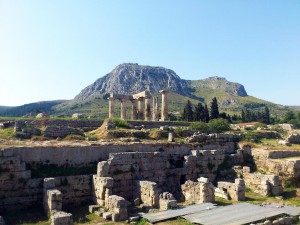 The archaeological site of Ancient Corinth is situated in a village bearing the same name, only a few kilometers from the modern town of Corinth. The area was first inhabited during the Neolithic period, at the eastern foothills of Acrocorinth hill. It was developed in a strategic location; were land communication could be controlled between Peloponnesus and Central Greece, it had fresh water and it oversaw the fertile valley of Corinth. It was perfectly positioned and for that reason the settlement did not change location until the Middle Ages.
The archaeological site of Ancient Corinth is situated in a village bearing the same name, only a few kilometers from the modern town of Corinth. The area was first inhabited during the Neolithic period, at the eastern foothills of Acrocorinth hill. It was developed in a strategic location; were land communication could be controlled between Peloponnesus and Central Greece, it had fresh water and it oversaw the fertile valley of Corinth. It was perfectly positioned and for that reason the settlement did not change location until the Middle Ages.
Video by fabdrone
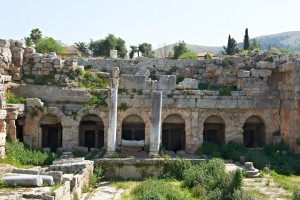 The peak period of ancient Corinth begins with the foundation of its colonies, mainly Corcyra and Syracuse. The Corinthians introduced the trireme to Greece. Ancient Corinth was the most significant commercial destination in the Greek territory. The excavations brought to light the imposing temple of Apollo, the Agora, the temple of Octavia, the shops of Lechaion road, Apostle Paul’s Podium, the theater and the Odeon.
The peak period of ancient Corinth begins with the foundation of its colonies, mainly Corcyra and Syracuse. The Corinthians introduced the trireme to Greece. Ancient Corinth was the most significant commercial destination in the Greek territory. The excavations brought to light the imposing temple of Apollo, the Agora, the temple of Octavia, the shops of Lechaion road, Apostle Paul’s Podium, the theater and the Odeon.
Source: www.mythicalpeloponnese.gr
The archaeological site of Heraion is located 15 kilometers to the northwest of Ancient Corinth, at the end of Perachora peninsula. Excavations carried out in the region have brought to light the temple of Hera and significant remains of the early Corinthian civilization, such as an L-shaped stoa, a large cistern, dining rooms and a smaller temple.
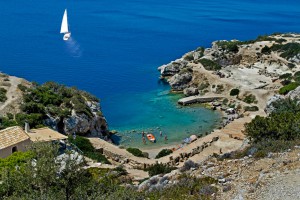 The temple of Hera is the most significant monument of the site. It lies near a small harbor under the lighthouse of Melagavi. The region was an important part of the Corinthian land during the early roman period. The findings in Perachora provide valuable information on Corinthian art from the geometric and archaic period. Excavations (1930-1933) were carried out at the site of Heraion and the temple of Hera Akraia, above the harbor, and Hera Limenia, by the harbor. The investigation extended to Vouliagmeni lake, and it attested the existence of remains that date back to the Neolithic, early Helladic and Mycenaean age. It is believed that a significant town called Heraion existed on the site. The findings in the area indicate that the town Oinoi was located in the area of Schoinos, and that the settlement of Therma was located in the modern town of Loutraki.
The temple of Hera is the most significant monument of the site. It lies near a small harbor under the lighthouse of Melagavi. The region was an important part of the Corinthian land during the early roman period. The findings in Perachora provide valuable information on Corinthian art from the geometric and archaic period. Excavations (1930-1933) were carried out at the site of Heraion and the temple of Hera Akraia, above the harbor, and Hera Limenia, by the harbor. The investigation extended to Vouliagmeni lake, and it attested the existence of remains that date back to the Neolithic, early Helladic and Mycenaean age. It is believed that a significant town called Heraion existed on the site. The findings in the area indicate that the town Oinoi was located in the area of Schoinos, and that the settlement of Therma was located in the modern town of Loutraki.
Video by fabdrone
Source: www.mythicalpeloponnese.gr
Every summer a series of cultural events take place for all, locals and visitors of Kiato. Concerts, plays, exhibitions, sport events, are but a few of the happenings during summer. Almost every day, from July until August, there is something to enjoy or take part it.
Source: www.mythicalpeloponnese.gr
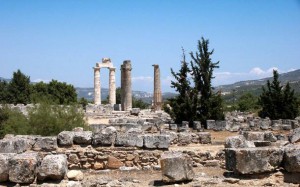
Nemea is a land of legends and traditions. It was the home land of the Nemean Lion, slayed by the legendary Hercules. The Nemean lion was a vicious monster that lived in a cave on mount Triton. Hercules trapped the beast and then killed it with his club. The archaeological site is located on the foothill of the mountains of Arcadia, 333 meters above sea level. The strategic location of Nemea and its climate were the reason that the Panhellenic Games of Nemean were held in the region. During the winter, the region was turned into a swamp, during the summer though it was the ideal place to practice sports. The most significant monuments of Nemea are the temple of Zeus and the Stadium. Since Nemea did not have residents, the management of the games belonged initially to Cleonae and then to Argos.
Source: www.mythicalpeloponnese.gr

